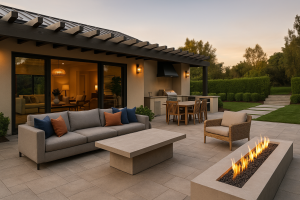Welcome to our comprehensive guide on fire-resistant roofs. When it comes to protecting your home from fire hazards, the choice of roofing material can make all the difference. Choosing the right roof can prevent or minimize fire damage and offer peace of mind to homeowners.
In this guide, we will explore the different types of fire-resistant roofing materials, including metal roofs, clay tiles, and asphalt shingles. We will discuss the fire-resistant properties of these materials, their durability, cost-effectiveness, and availability in various styles. We will also touch on alternative fire-resistant roofing options and the role of roofing design in fire protection.
Understanding Fire-Resistant Roofing Materials
When it comes to protecting your home from fire hazards, choosing the right roofing material is crucial. Not all materials are created equal in terms of fire resistance, and it’s important to understand the different options available.
Here are some of the most popular fire-resistant roofing materials:
| Roofing Material | Fire-Resistance Rating |
|---|---|
| Metal Roofs | Class A |
| Clay Tiles | Class A |
| Asphalt Shingles | Class A and Class B |
Understanding Fire-Resistant Roofing Materials
Let’s take a closer look at each of these materials and their fire-resistant properties.
Metal Roofs: The Ultimate Fire-Resistant Choice
Metal roofs are a popular choice for their durability, longevity, and non-combustible nature. They are also highly resistant to lightning strikes and sparks from nearby fires.
Most metal roofs have Class A fire-resistance ratings, which means they can withstand severe exposure to fire. In addition, some metal roofs come with a fire-resistant coating that can further enhance their protection against flames.
Clay Tiles: A Traditional Fire-Resistant Option
Clay tiles have been used as a fire-resistant roofing material for centuries. They are made by firing clay at high temperatures, which makes them highly resistant to heat and flames. They are also resistant to insects, rot, and decay, making them a durable and long-lasting option.
Clay tiles have a Class A fire-resistance rating and are an excellent choice for homes in areas prone to wildfires.
Asphalt Shingles: An Affordable Fire-Resistant Alternative
Asphalt shingles are a popular and affordable roofing option that comes in a range of styles and colors. They are made of fiberglass or organic materials that are then coated with asphalt and granules.
Asphalt shingles can have Class A or Class B fire ratings, depending on the manufacturer and the specific product. They are also easy to install and require minimal maintenance.
Metal Roofs: The Ultimate Fire-Resistant Choice
Metal roofs are gaining popularity as a fire-resistant roofing option due to their durability and non-combustibility. In addition to their fire-resistance, metal roofs are also resistant to insect damage, rot, and can withstand extreme weather conditions.
One of the biggest advantages of metal roofs in terms of fire protection is their ability to withstand high temperatures. Unlike traditional roofing materials, metal does not ignite or contribute to the spread of fire. Furthermore, metal roofs have a Class A fire rating, which is the highest rating for fire protection.
| Fire-Resistant Properties of Metal Roofs | Benefits of Metal Roofs in Fire Protection |
|---|---|
| – Non-combustible – Does not ignite or contribute to fire spread – Resistant to flying embers and sparks |
– Class A fire rating – Can withstand high temperatures – Durable and long-lasting – Requires little maintenance |
Cost of Metal Roofs
While metal roofs may be more expensive than traditional roofing materials, their long lifespan and durability make them a cost-effective investment in the long run. Additionally, the potential savings on insurance premiums due to their fire-resistant properties can offset the initial cost.
It is important to note that metal roofs can also provide energy savings due to their reflective properties, which can reduce energy consumption and costs associated with air conditioning.
Clay Tiles: A Traditional Fire-Resistant Option
Clay tiles are a popular choice for homeowners looking for a traditional aesthetic combined with fire-resistant properties. Made from natural clay, these tiles are durable and long-lasting, with a lifespan of up to 100 years. Their hard surface and weight make them resistant to wind and impact damage, as well as providing protection against fire.
| Advantages | Disadvantages |
|---|---|
| Fire-resistant properties | Higher cost compared to other roofing materials |
| Longevity and durability | Increased weight may require additional structural support |
| Minimal maintenance required | May crack or break under extreme weather conditions |
Clay tiles have natural fire-resistant properties that can help to limit the spread of fire. They do not burn or release any toxic fumes when exposed to heat or flame, making them a safe option for areas prone to wildfires. Their increased weight may require additional structural support during installation, but their long lifespan and low maintenance requirements can make them a cost-effective choice in the long run.
It’s important to note that not all clay tiles are created equal when it comes to fire resistance. Make sure to choose tiles that have been tested and certified to meet fire safety standards, and ensure proper installation to maximize their fire-resistant properties.
Asphalt Shingles: An Affordable Fire-Resistant Alternative
Asphalt shingles are a popular roofing material that can also provide fire-resistance. They are affordable and readily available, making them a suitable option for homeowners looking for fire-resistant roofing on a budget.
Asphalt shingles contain a fiberglass mat covered with asphalt and mineral granules. These materials provide excellent fire resistance, making them suitable for areas prone to wildfires.
| Advantages of asphalt shingles: |
|---|
| Cost-effective compared to other fire-resistant options |
| Available in various styles and colors |
| Durable and long-lasting |
Some asphalt shingles have a Class A fire rating, which is the highest rating for fire resistance. This means that these shingles can withstand severe fire exposure and can resist flames for up to two hours. However, it’s important to note that the fire resistance of asphalt shingles can decrease over time due to wear and tear or weathering.
When installing asphalt shingles, it’s important to follow proper installation techniques to ensure maximum fire resistance. This includes proper ventilation to prevent heat buildup and using fire-resistant underlayment.
Asphalt Shingle vs. Other Materials
Compared to other fire-resistant roofing materials, such as metal and clay tiles, asphalt shingles are a more affordable option. However, they may not have the same level of fire resistance as these materials.
Metal roofs have excellent fire-resistant properties, making them suitable for areas prone to wildfires. They are also durable and long-lasting, but can be more expensive than asphalt shingles. Clay tiles are another traditional fire-resistant option, with a long lifespan and the ability to minimize the spread of fire. However, they can be heavy and require additional support during installation.
Ultimately, the choice of fire-resistant roofing material will depend on factors such as budget, climate, and personal preference.
Other Fire-Resistant Roofing Options
In addition to metal roofs, clay tiles, and asphalt shingles, there are other fire-resistant roofing materials to consider.
| Roofing Material | Fire-Resistant Properties |
|---|---|
| Concrete tiles | Non-combustible and can withstand high temperatures. |
| Synthetic roofing | Made from fire-retardant materials and can offer class A fire protection. |
| Treated wood shakes | Treated with fire-retardant chemicals to reduce the spread of fire. |
When selecting a fire-resistant roofing material, it is important to consider the specific needs and requirements of your home, as well as the potential risks in your area. Professional roofing contractors can provide guidance on choosing the best option for your home.
The Role of Roofing Design in Fire Protection
In addition to selecting the right roofing materials for fire resistance, the design of the roof can also play a significant role in protecting a home from fire hazards.
Proper ventilation is key to reducing the risk of fire, as it allows heat to escape and prevents the buildup of flammable gases. Ridge vents, soffit vents, and gable vents are common options for ensuring adequate ventilation in the attic space.
Additionally, the installation of a fire-resistant underlayment can provide an extra layer of protection. This material is placed under the roof covering and provides a barrier against heat and flames.
The slope of the roof can also impact fire safety, as a steeper slope can facilitate the runoff of burning debris and prevent it from accumulating on the roof.
Finally, it is important to ensure proper installation techniques are followed to prevent any gaps or weaknesses in the roof’s fire protection. Working with a professional roofing contractor who is experienced in fire-resistant roof installation is recommended to ensure compliance with safety standards.
Importance of Regular Roof Maintenance and Inspection
Regular maintenance and inspection of your fire-resistant roof are critical in preventing potential hazards and ensuring its effectiveness in case of a fire. Here are some crucial considerations to keep in mind:
| Activity | Frequency |
|---|---|
| Roof cleaning and debris removal | Twice a year or as needed |
| Inspection for damage, leaks, and wear and tear | Once a year or as needed |
| Clean and maintain gutters and downspouts | Twice a year or as needed |
During inspections, check the roof’s vents, flashings, and chimney for debris accumulation, cracking, or damage. Similarly, it’s essential to ensure proper installation of vents and seals to prevent embers and hot gases from penetrating your roof’s surface. Any damage or wear and tear found during the inspection should be addressed promptly and professionally.
Additionally, keep surrounding trees trimmed away from your roof to reduce the risk of wildfires. Most essential, make sure to comply with any local laws and regulations around fire safety and prevention measures.
Hiring Professional Roofing Contractors for Fire-Resistant Roofs
Installing a fire-resistant roof is a crucial step in protecting your home or business from fire hazards. To ensure that the job is done right, it is essential to hire a professional roofing contractor with extensive experience in fire-resistant roof installation.
A certified and experienced roofing contractor will have the knowledge and expertise to recommend the best fire-resistant roofing materials for your specific needs and budget. They can also advise on roofing design options that can enhance the fire protection measures of your roof.
When hiring a professional roofing contractor, it is important to ensure that they are licensed and insured. This will protect you from liability in case of any accidents or damages that may occur during the installation process. Additionally, a professional contractor will comply with all safety standards and codes to ensure that the roof is installed properly and safely.
Fire-resistant roofs require specialized skills and expertise to install, and it is not recommended to attempt this as a DIY project. By hiring a professional roofing contractor, you can have peace of mind knowing that your fire-resistant roof is installed correctly and will provide the necessary protection for your home or business.
Fire-Resistant Roofing and Insurance Benefits
Choosing a fire-resistant roof not only helps protect your home and loved ones, but it can also have potential insurance benefits. Insurance companies often offer lower premiums or added coverage for homes with fire-resistant roofs. Here’s what you need to know:
| Insurance Benefits | Description |
|---|---|
| Lower Premiums | Insurance companies may offer lower premiums for homes with a fire-resistant roof as they are less likely to suffer from fire damage. |
| Added Coverage | Some insurance policies provide additional coverage for homes with fire-resistant roofs, such as protection against wildfire damage. |
| Peace of Mind | Investing in a fire-resistant roof provides peace of mind that your home is protected from fire hazards, and insurance benefits can offer added security. |
FAQs about Fire-Resistant Roofs
As a homeowner, you may have plenty of questions about fire-resistant roofs. Here are some answers to the most frequently asked questions:
1. How often do fire-resistant roofs need to be maintained?
Fire-resistant roofs generally require the same level of maintenance as regular roofs. However, it’s important to inspect the roof for any damage or wear that could compromise its fire-resistant properties.
2. Are fire-resistant roofs more expensive than regular roofs?
Fire-resistant roofs may cost more than regular roofs, but they are a wise investment in protecting your home from potential fire hazards. The cost may also vary depending on the material and the complexity of the installation.
3. Can fire-resistant roofs be installed with solar panels?
Yes, fire-resistant roofs can be installed with solar panels. However, it’s important to consult with a professional roofing contractor to ensure proper installation and compatibility with the roofing material.
4. Do fire-resistant roofs qualify for insurance discounts?
Many insurance companies offer discounts for homes with fire-resistant roofs. Be sure to check with your insurance provider to see if you qualify for any discounts or added coverage.
5. How long does a fire-resistant roof last?
The lifespan of a fire-resistant roof varies depending on the material and the quality of the installation. Metal roofs and clay tiles can last up to 50 years, while asphalt shingles can last up to 25 years.
6. Should I hire a professional roofing contractor to install a fire-resistant roof?
Yes, it’s important to hire a professional roofing contractor for the installation of a fire-resistant roof. They have the experience and expertise to ensure proper installation and compliance with safety standards.
7. What are some design elements that can enhance fire protection on the roof?
Proper ventilation, non-combustible materials, and fire-resistant underlayment are some design elements that can enhance fire protection on the roof. Consult with a professional roofing contractor to learn more about fire protection measures for your specific home.








